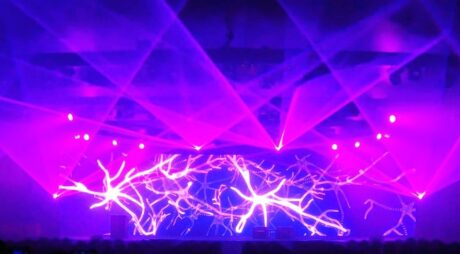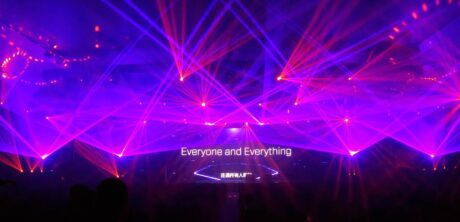
SHANGHAI – Technology, even at its highest levels, seems to be most impressive when it’s accompanied by human ingenuity. Nick Ho and his team demonstrated that point in convincing fashion recently at MWC19 Shanghai (short for Mobile World Congress). Putting on light shows for some of the brightest minds in tech, and surrounded by cutting edge contrivances like self-driving cars, 5G mirrors and 8K 360° virtual reality experiences, Ho navigated his way through time constraint issues to interface on short notice with some advanced laser software. Helping him accomplish this feat were his own resourcefulness, and the flexibility of his personal tech tool, the ChamSys MagicQ MQ60 console.
More details from Chamsys (www.chamsyslighting.com):
“For the past few years of the MWC event, I have programmed the conference’s opening stinger (walk-up music for the speaker introduction) with lights,” said Ho. “This year, my client decided to build this show around laser fixtures. We had to use Pangolin Beyond software. Now, my MQ60 receives Timecode via SMPTE LTC, but our Pangolin was not able to receive LTC due to the short notice we were given, which left us no time to prepare the LTC convert for Pangolin.”

Ho credits “ChamSys flexibility” with helping him and his team employ an effective workaround that overcame this challenge. “We used a feature in the ChamSys, called the ‘ArtNet Retransmit’,” he said. “This allowed us to use the MQ60 to transmit the incoming LTC to Pangolin via ArtNet.”
As a result, Ho and his colleagues, Justin Poh the MQ60 programmer, and Wang Jin, who programmed Pangolin Beyond, were able to create a stunning 8-universe show that married the best of lighting and lasers to captivated the tech savvy crowd at MCW19 Shanghai.
“Everyone was very pleased with how this show turned out,” said Ho. “There was a lot of movement, color, intensity, and multiple layers of looks. It represented the creative spirit of the conference. To blend laser and lighting with different cues and timing was interesting and challenging. I wrote all the cues, Justin programed them in the MQ60, and our laser assistant Wang programmed in Pangolin Beyond. I then did the final timecode touchup and operated the ChamSys console on the show days. It all went very smoothly.”
In addition to the laser displays, the opening day stinger was enlivened by a colorscape created with RGBA fixtures. “Our opening show featured seven different RGBW colors and some LED Ribbons,” said Ho. “The MQ60 can easily create a fixture profile within minutes in order to program the launching device that was built especially for this conference.”

Given the variety of roles they had to fill at MCW19 Shanghai from creating opening shows to lighting sessions, Ho and his team were continuously programming during the event. The user-friendliness and compact design of the MQ60 made it easier for them to keep up with this demand.
“Those who use it know that the MQ60 is very mobile and compact,” said Ho. “This was invaluable to us. For three days, we left the show floor with an hour of programming time remaining to be done. Not a problem – we just brought our ChamSys back to the hotel to finish the programming.”
Power and mobility — two of the three themes that ran through MCW19 Shanghai — also characterized the console that Ho and his team used to run the conference’s lightshows. As for the third theme, “ingenuity,” that was very evident in the collective imagination of the designers that worked this event to perfection.


